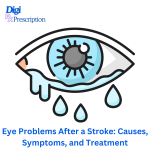
A stroke can have a profound impact on various bodily functions, including vision. Many stroke survivors experience eye problems, ranging from minor visual disturbances to severe vision loss. Understanding these issues and their potential treatments is crucial for recovery and improving quality of life.
In this blog post, we will explore common eye problems after a stroke, their causes, symptoms, and management strategies.
How a Stroke Affects Vision
Since vision processing happens in the occipital lobe, brainstem, and optic pathways, any damage to these areas can cause eye problems.
Types of Strokes That Affect Vision
✔ Ischemic Stroke – A blood clot blocks an artery, reducing blood flow to the brain.
✔ Hemorrhagic Stroke – A weakened blood vessel bursts, causing bleeding in the brain.
✔ Brainstem Stroke – Affects movement, eye coordination, and visual processing.
Common Eye Problems After a Stroke
1. Vision Loss (Hemianopia & Quadrantanopia)
A stroke can damage the visual cortex, leading to partial or complete vision loss in one or both eyes.
Types:
-
Hemianopia – Loss of vision in half of the visual field (left or right side).
-
Quadrantanopia – Loss of vision in one-quarter of the visual field.
Symptoms:
✔ Difficulty seeing on one side
✔ Bumping into objects on the affected side
✔ Struggling to read or recognize faces
Treatment:
✔ Visual Scanning Therapy – Helps patients consciously turn their head to compensate for blind spots.
✔ Prism Glasses – Shift the visual field to improve awareness.
✔ Adaptive Reading Strategies – Using larger fonts and highlighting text to aid reading.
2. Blurred or Double Vision (Diplopia)
A stroke can weaken eye muscles, leading to misalignment of the eyes and causing double vision.
Symptoms:
✔ Seeing overlapping images
✔ Difficulty focusing
✔ Eye strain and headaches
Treatment:
✔ Eye Patching – Covering one eye temporarily to reduce double vision.
✔ Prism Lenses – Correct misaligned vision.
✔ Eye Muscle Exercises – Strengthen the eye muscles and improve coordination.
3. Drooping Eyelid (Ptosis)
Damage to the nerves controlling eyelid movement can cause ptosis (drooping eyelid).
Symptoms:
✔ One eyelid appears lower than the other
✔ Difficulty keeping the affected eye open
✔ Impaired vision due to eyelid covering the eye
Treatment:
✔ Eyelid Exercises – Help strengthen the muscles.
✔ Surgery (If Severe) – To lift the eyelid.
4. Eye Movement Disorders (Strabismus & Nystagmus)
A stroke can affect the nerves controlling eye movements, leading to misalignment or involuntary eye shaking.
Types:
✔ Strabismus – One eye turns inward, outward, up, or down.
✔ Nystagmus – Uncontrolled, repetitive eye movements.
Symptoms:
✔ Trouble tracking moving objects
✔ Dizziness and balance issues
✔ Jerky or bouncing vision
Treatment:
✔ Vision Therapy – Eye exercises to improve coordination.
✔ Botox Injections – Relax overactive eye muscles.
✔ Prism Glasses – Help correct misalignment.
5. Light Sensitivity & Glare Issues
Stroke survivors often report increased sensitivity to light (photophobia), making bright lights uncomfortable.
Symptoms:
✔ Pain or discomfort in bright light
✔ Squinting or difficulty adjusting to different lighting conditions
Treatment:
✔ Wear Tinted Glasses – Helps reduce glare.
✔ Adjust Screen Brightness – Use warm tones or blue light filters.
✔ Avoid Harsh Lighting – Use softer, dimmable lights indoors.
6. Visual Neglect (Spatial Awareness Issues)
Some stroke survivors experience visual neglect, where they fail to notice objects or people on one side.
Symptoms:
✔ Ignoring objects on the left or right
✔ Difficulty eating food on one side of the plate
✔ Struggling to navigate through spaces
Treatment:
✔ Visual Scanning Therapy – Trains the brain to be more aware of the affected side.
✔ Contrast & Markers – Using bright-colored objects to attract attention.
7. Dry Eyes & Reduced Blinking
A stroke can affect the nerves controlling eyelid movement, leading to reduced blinking and dry eyes.
Symptoms:
✔ Redness and irritation
✔ Burning or foreign body sensation
✔ Excessive tearing (as a reflex to dryness)
Treatment:
✔ Artificial Tears – Lubricate the eyes.
✔ Blinking Exercises – Help re-establish natural blinking patterns.
✔ Humidifiers – Prevent dryness in indoor spaces.
How to Improve Vision After a Stroke
✔ Regular Eye Checkups – Monitor vision changes and seek professional advice.
✔ Physical & Occupational Therapy – Helps with balance and spatial awareness.
✔ Home Adjustments – Use bright colors, contrast strips, and larger text for easier navigation.
✔ Practice Eye Exercises – Improves coordination and focus.
✔ Consider Vision Aids – Special glasses, magnifiers, and reading tools can help.
When to See an Eye Doctor
Consult an eye specialist if you experience:
✔ Sudden vision loss or blurred vision
✔ Persistent double vision
✔ Difficulty focusing or reading
✔ Increased sensitivity to light
Conclusion
Stroke-related eye problems can impact daily life, making tasks like reading, driving, and walking more challenging. However, with proper treatment, therapy, and visual rehabilitation, many stroke survivors regain partial or full vision over time. If you or a loved one has experienced a stroke, consult an eye doctor or neurologist for personalized care.
References:
-
American Stroke Association (ASA) – Stroke and Vision Problems – https://www.stroke.org
-
National Eye Institute (NEI) – Vision Impairment After Stroke – https://www.nei.nih.gov
-
Mayo Clinic – Stroke and Its Effects on Vision – https://www.mayoclinic.org
-
American Academy of Ophthalmology (AAO) – Post-Stroke Vision Therapy – https://www.aao.org
